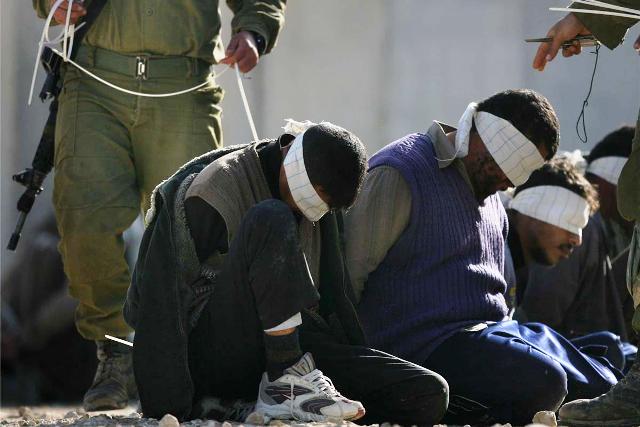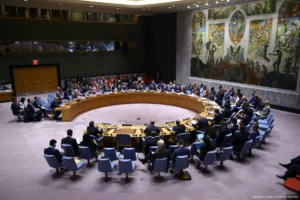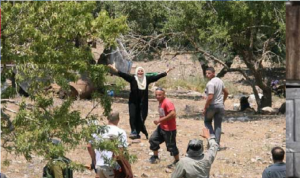palestinians-being-arrested-by-israeli-soldiers-palestinian-prisoners-detainees-300x200.jpg" alt="Methods range between severe beatings, putting prisoners under cold water followed by hot water, cuffing or restraining them with their arms behind them and then tying them to a door or window for long periods of time, often lasting hours. (Photo: MEMO)" width="404" height="269" /> Methods range between severe beatings, putting prisoners under cold water followed by hot water, cuffing or restraining them with their arms behind them and then tying them to a door or window for long periods of time, often lasting hours. (Photo: MEMO)
Tel Aviv, 6 Muharram 1436/30 October 2014 (MINA) – Hundreds of torture methods used against Palestinian prisoners during interrogations conducted in Israeli prisons have been observed by human rights organisations and prisoners’ rights associations.
A report by the United Nations lists around 200 methods of torture. The Israeli rights group B’Tselem listed around 105 torture methods. Regardless of the number, all these reports indicate a grave level of violations perpetrated against Palestinians following their arrest, according to Middle East Monitor (MEMO) reports quoted by Mi’raj Islamic News Agency (MINA), Thursday.
Fouad Khuffash, director of the Ahrar Centre for Prisoners’ Studies and Human Rights, suggests that torture can be divided into two categories; physical and psychological. Some believe that psychological torture is less harmful than physical torture, but the mental scars left by both can leave prisoners traumatised long after their release.
Khuffash adds: “Torture in Israeli prisons is systematic and starts from the moment a prisoner is arrested, not from the moment they begin interrogation. This is a premeditated and staged scenario that changes according to the case of the detainee and the nature of their file. Investigators alternate and play various roles assigned in advance to each investigator.”
Also Read: UN Says Israel Blocking Vital Tent Deliveries to Gaza
Fahd Abu Al-Hajj, director of the Abu Jihad Centre for Prisoner Affairs at the University of Jerusalem, noted that there are 73 methods of interrogation considered to be the “most popular” in Israeli jails. These methods demonstrate the barbarism of the occupation and its lack of respect for basic standards of human rights, he stated.
He added: “Nothing evidences this more than the repeated death of prisoners under interrogation, the most recent of which was the death of the prisoner Raed Al-Jabari.”
Al-Hajj believes that the use of torture is systematic, adopted by the Israeli intelligence services and that no prisoner detained in any Israeli prison is spared.
He also explained that these methods range between severe beatings, putting prisoners under cold water followed by hot water, cuffing or restraining them with their arms behind them and then tying them to a door or window for long periods of time, often lasting hours. Prisoners are also made to sit on chairs and beaten with sticks until they lose consciousness. These beatings may target sensitive areas of their bodies which have the potential to leave long-term negative effects, sometimes leading to chronic diseases.
Also Read: 98 Palestinian Detainees Have Died in Prisons Since Gaza War Began
Forms of torture
Israeli human rights organisation B’Tselem acknowledged in its report that 105 torture methods are used against Palestinian detainees which are considered serious violations of human rights. A UN human rights committee described the torture in Israeli prisons as “crossing the line”, noting that Israel’s brutal methods of torture included breaking backs, pulling fingers apart and twisting testicles.
Israeli intelligence bases their torture of detainees on the so-called secret guidelines that were approved in 1987, after the outbreak of the first Intifada. These guidelines allow them to apply “moderate” physical and psychological pressure on prisoners. This gives a legal cover to the torture practiced by Israeli intelligence agents.
In the last 10 years, interrogators have decreased their use of torture, moving away from physical torture and instead used harsh psychological methods that can leave enduring scars, while continuing to use direct physical torture of varying degrees.
Mohammed Kilani, who has experienced many interrogations, noted that his solitary confinement which exceeded two months during which he was forced to remain chained to a chair, was the harshest method of torture he has suffered.
Also Read: Palestinian Killed by Israeli Drone Strikes as Ceasefire Violations Continue in Gaza
He also added that throughout the entire prison system across the globe, there exists no torture method that has not been thought of or used by the Israeli authorities at some point.
According to statistics, around 72 prisoners were killed as a result of torture in Israeli prisons since 1967, out of a total number of over 200 prisoners who died behind bars.
The first prisoner to die as a result of being tortured was Yousef Al-Jabali who died on January 4 1968 in a Nablus prison. Many prisoners have since followed him, such as Qassem Abu Akar, Ibrahim Al-Rai, Abdul Samad Harizat, Attia Za’anin, Mustafa Akkawi, and others, including the most recent, Raed Al-Jabari. (T/P3/R01)
Mi’raj Islamic News Agency (MINA)
Also Read: Hamas Announces Continued Search for Israeli Captives’ Bodies Despite Difficulties































 Mina Indonesia
Mina Indonesia Mina Arabic
Mina Arabic